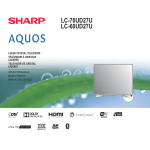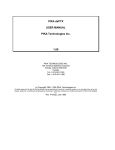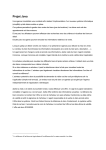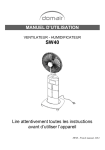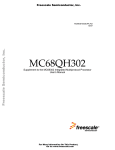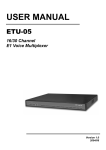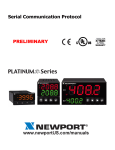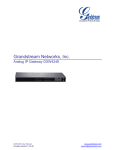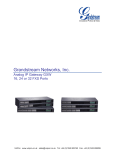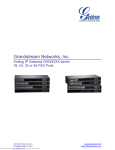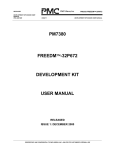Download 98 KB - PIKA Technologies
Transcript
PIKA DAYTONA™ Voice Card Hardware Manual 1.1 TECHNOLOGIES INC. 155 Terrence Matthews Crescent Kanata, Ontario K2M 2A8 Canada Tel: 1-613-591-1555 Fax: 1-613-591-1488 © Copyright 1989 - 1996 PIKA Technologies Inc. All rights reserved. No part of this document may be reproduced, stored in a retrieval system, or in any other form or by any means, electronic, mechanical, photocopying, recording or otherwise, without prior written permission of PIKA Technologies Inc. This Printing: April 1996 Table of Content 1 INTRODUCTION ..............................................................................1 2 DAYTONA DESCRIPTION .............................................................2 2.1 SWITCHING CAPABILITY .................................................................2 2.2 TELEPHONE LINE PORTS (DOMESTIC VARIANTS) ..........................4 2.3 TELEPHONE LINE PORTS (INTERNATIONAL VARIANTS) ................11 3 HARDWARE INSTALLATION....................................................13 3.1 PC INSTALLATION ........................................................................14 3.1.1 Setting Base I/O Address ......................................................14 3.2 TELEPHONE LINE PORTS SETUP....................................................16 3.2.1 Domestic Variants ................................................................16 3.2.2 International Variants ..........................................................19 3.3 MVIP BUS SETUP ........................................................................22 APPENDIX A MVIP BUS ..................................................................23 APPENDIX B REGULATORY WARNINGS .................................26 B.1 INDUSTRY CANADA INFORMATION ..............................................26 B.2 FCC INFORMATION .....................................................................28 1 Introduction The PIKA DAYTONA card is family of IBM AT (ISA) bus compatible DSP resource cards for use in PC based voice systems. The DAYTONA family provides up to 24 analog telephone line interfaces in a variety of different configurations. The cards are fully MVIP bus (Multi-Vendor Interface Protocol) compliant, allowing them to be interconnected with any other MVIP compatible cards in the host system. The following table lists the available variants within the DAYTONA card family, showing analog line configuration and DSP audio processing power in MIPS: Domestic Variants: MODEL 24P 24L 12P 12L 8P4L 16P8L POTS Lines 24 0 12 0 8 16 International Variants: MODEL POTS Lines 12L-i 12L-i/GT 0 0 DAYTONA Hardware Manual Analog Loop Start Lines 0 24 0 12 4 8 DSP MIPS Analog Loop Start Lines 12 12 DSP MIPS 60 60 30 30 30 60 30 60 1 2 DAYTONA Description The DAYTONA family cards are IBM AT (ISA) bus compatible, providing analog interfaces to telephone lines of various types. These cards have up to two on board DSP devices, can support one V-ENGINE DSP module, and an MVIP connector for interconnection to other compatible devices in the host system. Both cards provide MVIP compatible circuit switching for 512 time slots. 2.1 Switching Capability The DAYTONA supports a central digital switching matrix based on the industry standard FMIC device. The switch matrix is used for connecting the audio Input/Outputs of voice/data resources together, including Line Circuits, DSP devices and MVIP Bus. DAYTONA Hardware Manual 2 The switch matrix on the card is classed as MVIP Enhanced Compliant which means it can connect to the MVIP on the full 512 channel switching capability, and can switch internal resources without using the MVIP Bus. The following diagram graphically illustrates the digital switching paths available on the DAYTONA:. Note that any input to the DAYTONA switch matrix can be connected to any output of the matrix. DAYTONA SWITCH MATRIX MVIP BUS MVIP BUS DSo 0-7 IN 0-7 OUT 0-7 DSi 0-7 DSi 0-7 IN 8-15 OUT 8-15 DSo 0-7 DSPs DSPs Out IN 16-19 OUT 16-19 Lines Circuits Out In Line Circuits IN 20 DAYTONA Hardware Manual OUT 20 In 3 2.2 Telephone Line Ports (Domestic Variants) The DAYTONA card is assembled in a number of configurations, consisting of combinations of Loop Start and POTS type telecom line interfaces. 2.2.1 LOOP START Line DAYTONA VERSIONS: 12L, 24L, 8P4L, 16P8L Loop Start line interfaces provide a termination which behaves the same way that a telephone set does when connected to a wall plug (i.e. PBX or Public Network port). The DAYTONA Loop Start Line ports initiate outbound calls by going OFFHOOK and dialing, and they take incoming calls by detecting ringing voltage then going OFFHOOK. The DAYTONA card’s dowloadable onboard firmware performs all real-time related LOOP START line functions including supervision of RINGING voltage, BATTERY REVERSAL and LOOP CURRENT DISCONNECT. The card performs signaling functions including generation of OFFHOOK, DIALING and HOOKFLASH signals. The DAYTONA line interface supports high impedance audio reception during the on-hook state, allowing the card to perform tasks such as CLASS signaling (Caller I.D.), KT23 signaling (onhook DTMF detection), and high impedance audio logging. The following specifications apply to the Loop Start Line interface: Signaling: DC resistance: 250-325 ohms DC current range: 18 - 90 mA Supervision: Ringing: Voltage detection Loop current disconnect Battery reversal (Factory option) DAYTONA Hardware Manual 4 Transmission: AC Impedance ONHOOK: > 10Kohm at 20Hz. AC Impedance OFFHOOK: 600ohms. The following shows typical applications of Loop Start lines on the DAYTONA 24L: DAYTO NA 24L PBX or P U B L IC NETW O RK 24 L O O P S T A R T L IN E C O N N E C T IO N PH O NES PBX or 24 P U B L IC NETW ORK D A YTO N A 24L B R ID G E D C O N N E C T IO N S DAYTONA Hardware Manual 5 2.2.2 POTS Line DAYTONA VERSIONS: 12P, 24P, 8P4L, 16P8L POTS line (Plain Old Telephone Set) interfaces also known as SLICS provide talk battery (-48 volts DC) and ringing voltage (90 VAC/20Hz). The DAYTONA card’s downloadable onboard firmware performs all real-time related POTS line functions. The following specifications apply to the DAYTONA family POTS Line interface: Current Feed: DC resistance: 400 ohms DC current range: 18 - 70 mA Ringing Voltage: Cadence: Software programmable. Power load distribution: programmable. Zero Cross switching. Supervision: OFFHOOK/ONHOOK Ring Trip HOOKFLASH Transmission: AC Impedance: 600ohms. DAYTONA Hardware Manual 6 The following shows a typical application of POTS Lines on the DAYTONA 24P: P ow er S upply D A Y TO N A 24P -48V D C 90V A C PHONES 24 P O TS LIN E C O N N E C TIO N DAYTONA Hardware Manual 7 2.2.3 Voltage Sense Output DAYTONA VERSIONS: 12P, 24P, 8P4L, 16P8L All versions of the DAYTONA supporting POTS lines provide a pair of wires on the telecom connector for use as a Voltage Sense output. The typical application for the Voltage Sense output pair is for remote control of a Power Fail Transfer relay. The Voltage Sense output consists of a short circuit protected battery and ground pair routed from the external POTS line power supply. The following table details the Voltage Sense output characteristics: Output voltage Output resistance Maximum operating current Minimum short circuit current Short circuit recovery time -48 VDC 20 ohms 120 mA DC 500 mA DC 10 Seconds The following application shows how the Voltage Sense Output is typically used implement Power Fail Cut-through in conjunction with the DAYTONA 12P: DAYTONA Hardware Manual 8 P ow er S upply D A Y TO N A 12P -48V D C 90V A C P FT U N IT 12 X P O TS SENSE PHONES 12 NC NO 12 PU BLIC N ETW O R K S E N S E LIN E U S A G E DAYTONA Hardware Manual 9 2.2.4 Mixed Line Variants DAYTONA VERSIONS: 8P4L, 16P8L The DAYTONA 8P4L and 16P8L provide combinations of Loop Start and POTS Lines on the same card. The following application shows how the DAYTONA 8P4L is used: Power Supply DAYTONA 8P4L -48VDC 90VAC PHONES POTS X 8 8 LOOP X 4 4 PUBLIC NETWORK MIXED LINE CONNECTIONS DAYTONA Hardware Manual 10 2.3 Telephone Line Ports (International Variants) They Daytona family includes variants compatible with international standards. The difference between the domestic and international variants is only in the line interface circuitry. 2.3.1 International Loop Start Line DAYTONA VERSIONS: 12L-i, 12L-i/GT The International Loop Start line interface performs the same function as the standard Loop Start line interface (see 2.2.1), but is designed to provide higher isolation voltage. An additional feature of this circuit is the ability to select line supervision mode via jumper on a per circuit basis. If the jumper is installed, the circuit detects loop current disconnects like the North American circuit. If the jumper is removed, the circuit becomes polarity sensitive, thereby providing loop reversal detection. Refer to section 3 for location of these jumpers. This circuit supports high impedance audio reception during the on-hook state, allowing the card to perform tasks such as CLASS signaling (Caller I.D.), KT23 signaling (on-hook DTMF detection), and high impedance audio logging. The International Loop Start Line circuit supports the Ground Button signal for PBX alerting. This feature involves momentary connection of a third input lead (PBX GROUND) to the RING lead through an internal relay contact. The following specifications apply to the International Loop Start Line interface: Signaling: DC resistance: 400 ohms nominal. DC current range: 18 - 80 mA Supervision: Ringing: Voltage detection Loop current disconnect Battery reversal (jumper option) DAYTONA Hardware Manual 11 Transmission: AC Impedance ONHOOK: > 10Kohm at 20Hz. AC Impedance OFFHOOK: 600ohms. The following show typical applications of Loop Start lines on the DAYTONA 12L-i: D A Y T O N A 1 2 L -i P U B L IC NETW O RK 12 IN T E R N A T IO N A L L O O P S T A R T P S T N L IN E C O N N E C T IO N D A Y T O N A 1 2 L -i PBX T ip /R in g 12 G ro u n d IN T E R N A T IO N A L L O O P S T A R T P B X S T A T IO N L IN E C O N N E C T IO N DAYTONA Hardware Manual 12 3 Hardware Installation Before using the DAYTONA card, the following features must be setup: 1. PC Installation: • 2. Telephone lines: • • • 3. MVIP bus: • Card Base Address. Telephone line connections. External Power supply connection (POTS versions only). Line reverse/Loop current detector (International version only). MVIP bus termination. The following figure illustrates the DAYTONA card layout: INTERNAL PWR MVIP BUS MVIP Bus Terminations EXT PWR ADDRESS Switch PHONE LINES DAYTONA Hardware Manual 13 3.1 PC Installation All variants of the DAYTONA are installed in the host PC in the same way as described in this section. The card can be inserted in any free 8-bit or 16-bit slot, and does not use any hardware interrupts or system memory. 3.1.1 Setting Base I/O Address The DAYTONA card occupies 32 consecutive I/O addresses of the PC bus, and no system memory space. The start or Base address is user selectable, ensuring no conflicts with any type of peripheral card. Each DAYTONA card in the system is set to a different base address the BASE ADDRESS dipswitch located conveniently at the top of the card as shown: Base Address Switch (TOP VIEW) UP 1 2 3 DOWN 4 CIRCUIT BOARD 1 2 3 4 BASE ADDRESS D D D D D D D D U U U U U U U U D D D D U U U U D D D D U U U U D D U U D D U U D D U U D D U U D U D U D U D U D U D U D U D U 0x200 0x220 0x240 0x260 0x280 0x2A0 0x2C0 0x2E0 0x600 0x620 0x640 0x660 0x680 0x6A0 0x6C0 0x6E0 DAYTONA Hardware Manual 14 NOTE ABOUT BASE ADDRESS SELECTION: For historical reasons, the PC architecture defined by IBM restricts peripheral cards (i.e. non motherboard based devices) to using I/O addresses in the range 0x200 to 0x3FF, although the 286/386/486 processors actually support 16 bit I/O (0x0000 to 0xFFFF). The PIKA cards overcome this address space limitation by decoding the entire I/O address bus (A15-A0), providing paging into addresses above the standard range (i.e. 0x600 and above). Some older peripheral cards ignore address lines A10 to A15, meaning that these cards will decode addresses 0x600 to 0x6E0 as addresses 0x200 to 0x2E0. Selecting base addresses above 0x600 may not resolve conflicts between a PIKA card and other cards. The following figure illustrates how the PC’s I/O addresses are decoded by different cards: Description Standard decoding PIKA Low addresses PIKA High addresses A15A11 X A10 A9 A8 Decoded Address X 1 0 (0x200-0x2FF) +(0x600-0x6FF) X 0 1 0 0x200-0x2FF X 1 1 0 0x600-0x6FF DAYTONA Hardware Manual 15 3.2 Telephone Line Ports Setup The DAYTONA telephone line ports require onboard configuration, external connection and external power supply connection (depending on model in use). 3.2.1 Domestic Variants The domestic variants of the DAYTONA simply require that the analog lines be connected to the card and that an external battery and ringing supply be attached (where applicable). 3.2.1.1 Telecom Connector The lines are connected through an RJ-21style connector, with pinout as defined below: T IP 0 T IP 1 T IP 2 1 2 3 26 27 4 28 29 T IP 2 1 T IP 2 2 T IP 2 3 22 47 23 24 48 49 * S EN SE _G N D 25 50 T IP 3 R IN G 0 R IN G 1 R IN G 2 R IN G 3 R IN G 2 1 R IN G 2 2 R IN G 2 3 * SENSE_BAT * : o n P O T S O N L Y v a ria n ts Telco Connector (Domestic Version) DAYTONA Hardware Manual 16 The following table shows in detail the full telco connector pinout and line types for each DAYTONA mode (DOES NOT INCLUDE INTERNATIONAL VERSIONS OF THE CARD): PIN 1 2 3 4 5 6 7 8 9 10 11 12 13 14 15 16 17 18 19 20 21 22 23 24 25 SIG TIP0 TIP1 TIP2 TIP3 TIP4 TIP5 TIP6 TIP7 TIP8 TIP9 TIP10 TIP11 TIP12 TIP13 TIP14 TIP15 TIP16 TIP17 TIP18 TIP19 TIPI20 TIP21 TIP22 TIP23 S-GND PIN 26 27 28 29 30 31 32 33 34 35 36 37 38 39 40 41 42 43 44 45 46 47 48 49 50 SIG RING0 RING1 RING2 RING3 RING4 RING5 RING6 RING7 RING8 RING9 RING10 RING11 RING12 RING13 RING14 RING15 RING16 RING17 RING18 RING19 RING20 RING21 RING22 RING23 S-BAT 12L LOOP LOOP LOOP LOOP LOOP LOOP LOOP LOOP LOOP LOOP LOOP LOOP - 24L LOOP LOOP LOOP LOOP LOOP LOOP LOOP LOOP LOOP LOOP LOOP LOOP LOOP LOOP LOOP LOOP LOOP LOOP LOOP LOOP LOOP LOOP LOOP LOOP - 12P POTS POTS POTS POTS POTS POTS POTS POTS POTS POTS POTS POTS SENSE 24P POTS POTS POTS POTS POTS POTS POTS POTS POTS POTS POTS POTS POTS POTS POTS POTS POTS POTS POTS POTS POTS POTS POTS POTS SENSE 8P4L LOOP LOOP LOOP LOOP POTS POTS POTS POTS POTS POTS POTS POTS SENSE 16P8L LOOP LOOP LOOP LOOP LOOP LOOP LOOP LOOP POTS POTS POTS POTS POTS POTS POTS POTS POTS POTS POTS POTS POTS POTS POTS POTS SENSE The following diagram illustrates the pinout provided by the optional Telco line extender cable and RJ14 breakout connector: / RING0 TIP0 1 / / RING2 TIP2 2 / / RING22 TIP22 12 RING1 TIP1 RING3 TIP3 RING23 TIP23 / DAYTONA Hardware Manual 17 3.2.1.2 External Battery Supply DAYTONA Models: -12P, -24P, -8P4L, -16P8L Use of the POTS line circuits on the DAYTONA requires use of an external power supply for battery and ringing voltages as specified below: BATTERY: -48VDC, 60mA per POTS line. RINGING: 90VAC at -48VDC, 1 Watt per POTS line. Connection to the external battery supply can be made either at the bracket end of the card (‘EXTERNAL’) or directly on the card (INTERNAL), as shown in the following figures: 90 VAC / 20Hz GROUND -48 VDC EXTERNAL CONNECTOR -48 VDC GROUND 90 VAC / 20Hz N/C INTERNAL CONNECTOR DAYTONA Hardware Manual 18 3.2.2 International Variants The international variants of the DAYTONA have special line interface circuits to meet signaling and high voltage isolation requirements for type approvals. 3.2.2.1 Telecom Connector The International variants of the DAYTONA have a different pinout from the domestic version in order to maintain high voltage separation requirements, and to include the third ‘Ground Input’ lead: T IP 0 G nd 0 T IP 1 G nd 1 T IP 1 1 G nd11 1 2 3 26 R IN G 0 27 28 R IN G 1 4 29 22 47 23 24 48 49 25 50 R IN G 1 1 Telco Connector (International Version) DAYTONA Hardware Manual 19 The following diagram illustrates the pinout provided by the optional Telco line extender cable and breakout box: / 1 RING0 TIP0 Gnd 0 / / 2 RING1 TIP1 / Gnd 1 / 12 RING11 TIP11 / Gnd 11 RJ11 Breakout Cable (International Version) DAYTONA Hardware Manual 20 3.2.2.2 Loop Detector Setup The International versions, DAYTONA-i , -i/GT provide jumper options to configure the circuit’s loop current detector as a loop reversal detector. When the jumper is installed, the circuit detects loop current disconnects, regardless of line polarity. If the jumper is removed, the circuit becomes polarity sensitive, producing loop current disconnect indications when the line polarity is reversed. The following figure illustrates the position of loop current detector configuration jumpers on the board: Line 0 Line 11 Loop Detector Jumpers The following figure illustrates the correct line polarity for use when in loop reversal detection mode (RJ11 breakout cable): RJ11 Jack DAYTONA Hardware Manual TIP = Positive Lead RING = Negative Lead 21 3.2.2.3 Ground Button Setup The International versions, DAYTONA-i , -i/GT provide a third wire input at the line interface for PBX ground input. This signal is used in the generation of the Ground Button signal for PBX alerting. The following diagram illustrates connection of the Ground signal (RJ11 breakout cable): PBX Ground Lead TIP = Positive Lead RING = Negative Lead 3.3 MVIP Bus Setup The switch matrix on the card is classed as MVIP Enhanced Compliant which means it can connect to the MVIP on the full 512 channel switching capability, and can switch internal resources without using the MVIP Bus. In a multi card MVIP system, it is recommended that the MVIP bus clock master is positioned at one extremity of the MVIP cable. The card that is farthest away from the clock master is required to provide an AC termination of the bus clock signals. The position of the four MVIP bus terminator jumpers is shown in the card diagram of section 3.0. Install these jumpers to terminate the MVIP bus. DAYTONA Hardware Manual 22 Appendix A MVIP Bus The DAYTONA includes an MVIP connector, with full access to all 512 timeslots of the MVIP bus. The DAYTONA can be programmed under software to either SOURCE or to SINK (receive) the MVIP bus clocks and timing. A.1 Bus Details The MVIP bus (Multi-Vendor Interface Protocol) is a hardware standard which has been adopted by the PC based voice processing industry to provide a means of interconnecting cards from several vendors within a single chassis. The MVIP protocol defines a bus which provides a standard means for transmitting, receiving and switching digital data (PCM voice or video). The MVIP bus is organized as 16 digital links, running synchronously at 2.048 Mbits per second, with a frame rate of 125 microseconds (8Khz), divided into 32 time slots of 64Kbits per second. A pair of clock signals and a frame pulse are used to synchronize the data flowing on the bus. The result is a bus with a total capacity of 512 timeslots or channels which can be used either to transmit or receive data. The intention of the MVIP bus is to allow vendors of various resource cards to interconnect the audio ( or video) data between them to allow system integrators to create advanced voice and video processing systems. The MVIP bus is not intended to pass intelligent information between cards of different types, although proprietary implementations do not preclude its use in this fashion. The general philosophy of operation in an MVIP environment is that one card in the system is a master, providing clocks and circuit switching for the MVIP bus. Other details regarding distributed switching and clock redundancy, multi-chassis interconnection and software interface are covered in the MVIP specification, available either from Mitel Corporation or Natural Microsystems. DAYTONA Hardware Manual 23 A.2 MVIP Compatibility levels Devices connecting to an MVIP bus, can provide various levels of connectivity and compatibility. MVIP Compatible: A card which can connect to the MVIP bus but does not have full 512 channel switching capability. These cards typically use jumpers or software control to allow installers to configure the system. MVIP Compliant: A card which can connect to the MVIP bus, providing full 512 channel switching capability. This card type may have internal resources which use some of the MVIP bus channels to perform their functions. MVIP Enhanced Compliant: A card which can connect to the MVIP bus, providing full 512 channel switching capability, without using any of the MVIP bus channels for internal connection of its own resources. DAYTONA Hardware Manual 24 A.3 MVIP Connector The following table shows standard MVIP connector definition: pin 2 pin 1 pin 40 pin 19 MVIP PIN NAME DESCRIPTION MVIP PIN NAME DESCRIPTION 1 3 5 7 RES. RES. RES. DSo0 2 4 6 8 RES. RES. RES. DSi0 9 DSo1 10 DSi1 11 DSo2 12 DSi2 13 DSo3 14 DSi3 15 DSo4 16 DSi4 17 DSo5 18 DSi5 19 DSo6 20 DSi6 21 DSo7 22 DSi7 23 25 27 29 31 RES. RES. RES. RES. /C4 24 26 28 30 32 RES. RES. RES. GND GND Reserved Reserved Reserved Serial Data Stream In 0 Serial Data Stream In 1 Serial Data Stream In 2 Serial Data Stream In 3 Serial Data Stream In 4 Serial Data Stream In 5 Serial Data Stream In 6 Serial Data Stream In 7 Reserved Reserved Reserved Ground Ground 33 /F0 34 GND Ground 35 C2 36 GND Ground 37 SEC8K 38 GND Ground 39 RES. Reserved Reserved Reserved Serial Data Stream Out 0 Serial Data Stream Out 1 Serial Data Stream Out 2 Serial Data Stream Out 3 Serial Data Stream Out 4 Serial Data Stream Out 5 Serial Data Stream Out 6 Serial Data Stream Out 7 Reserved Reserved Reserved Reserved 4 MHz Bus Clock Ref. 8 KHz Frame Pulse 2 MHz bit clock 8 KHz Secondary Clock Reserved 40 RES. Reserved DAYTONA Hardware Manual 25 Appendix B Regulatory Warnings B.1 Industry Canada Information Equipment Attachment Limitations NOTICE: The Industry Canada label identifies certified equipment. This certification means that the equipment meets certain telecommunications network protective, operational safety requirements. The Department does not guarantee the equipment will operate to the user's satisfaction. Before installing this equipment, users should ensure that it is permissible to be connected to the facilities of the local telecommunications company. The equipment must also be installed using an acceptable method of connection. The customer should be aware that compliance with the above conditions may not prevent degradation of service in some situations. Repairs to certified equipment should be made by an authorized Canadian maintenance facility designated by the supplier. Any repairs or alterations made by the user to this equipment, or equipment malfunctions, may give the telecommunications company cause to request the user to disconnect the equipment. Users should ensure for their own protection that the electrical ground connections of the power utility, telephone lines and internal metallic water pipe system, if present, are connected together. This precaution may be particularly important in rural areas. Caution: Users should not attempt to make such connections themselves, but should contact the appropriate electric inspection authority, or electrician, as appropriate. Load Numbers (LN) The LOAD NUMBER (LN) assigned to each terminal device denotes the percentage of the total load to be connected to a telephone loop which is used by the device, to prevent overloading. The termination on a loop may consist of any combination of devices subject only to the requirement that the total of the Load Numbers of all the devices does not exceed 100. The load number of this device is : 20 Restrictions Concernant Le Raccordement De Materiel AVIS: L'etiquette du ministere de l’Industrie Canada indentifie le materiel homologue. Cette etiquette certifie que le materiel est conforme a certaines normes de protection, d'exploitation et de securite des reseaux de telecommunications. Le Ministere n'assure toutefois pas que le materiel fonctionnera a la satisfaction de l'utilisateur. Avant d'installer ce materiel, l'utilisateur doit s'assurer qu'il est permis de le raccorder aux installations de l'entreprise locale de telecommunication. Le materiel doit egalement etre installe en suivant une method acceptee de raccordement. L'abonne ne doit pas oublier qu'il est possible que la conformite DAYTONA Hardware Manual 26 aux conditions enoncees ce-dessus n'empechent pas la degradation du service dans certaines situations. Les reparations de materiel homologue doivent etre affectuees par un centre d'entretien canadien autorise designe par le fournisseur. La compagnie de telecommunications peut demander a l'uitilisateur de debrancher un appareil a la suite de reparations ou de modifications effectuees par l'utilisateur ou de modifications effectuees par l'utilisateur ou a cause de mauvais fonctionnement. Pour sa propre protection, l'utilisateur doit s'assurer que tous le fils de mise a la terre de la source d'energie electrique, des lignes telephoniques et de canalisations d'eau metallique, s'il y en a , sont raccordes ensemble. Cette precaution est particulierement importante dans le regions rurales. Avertissement: L'utilisatuer ne doit pas tenter de faire ces raccordements luimeme; il doit avoir recours a un service d'inspection des installations electriques, ou a electricien, selon le cas. L'indices de Charge (IC) L'indice de charge (IC) assigne a chaque dispositif terminal indique, pour eviter toute surcharge, le pourcentage de la charge totale qui peut etre raccordee a un circuit telephonique boucle utilise par ce dispositif. La terminaison du circuit boucle peut etre constituee de n'import quelle combinaison de dispositifs, pourvu que la somme des indices de charge de l'ensemble des dispositifs ne depasse pas 100. L’indice de charge de ce produit est: 20 DAYTONA Hardware Manual 27 B.2 FCC Information System Integrators This section contains information applicable to system integrators, to ensure the use of the PIKA DAYTONA Family (known as “PIKA DAYTONA”) complies with FCC part 68. i. The PIKA DAYTONA must be mounted into the final assembly so that it is isolated from exposure to any hazardous voltages with the assembly. Adequate separation and restraint of cables and cords must be provided. ii. The TIP/RING leads from the PIKA DAYTONA must be wired to the telephone lines in wiring that carries no other circuitry than that specifically allowed in FCC Part 68 rules. Any PC board traces carrying TIP/RING leads should have sufficient spacing to avoid surge breakdown. iii. The PIKA DAYTONA must be connected to a standard IBM XT/AT bus slot for correct power sources. iv. When the PIKA DAYTONA is enclosed within an assembly, a label shall be placed on the exterior of the cabinet listing registration numbers, and RENs of all registered devices contained therein. v. The final assembler shall provide in the user manual, the standard Exhibit J customer instructions as listed in section 6.2 below. Consumer Information The following information applies to consumers, and is also to be included by system integrators in their customer documentation. i. The PIKA DAYTONA complies with Part 15 and Part 68 of the FCC rules. Verified to comply with the limits for Class "B" Digital Device pursuant to Part 15 of FCC rules. These limits are designed to provide reasonable protection against harmful interference when the equipment is operated in a commercial environment. This equipment generates, uses, and can radiate radio frequency energy and, if not installed and used in accordance with the instruction manual, may cause harmful interference in which case the user will be required to correct the interference at his own expense. On the solder side of the PIKA DAYTONA board, is a label that contains the FCC registration number, and Ringer Equivalence Number (REN) for this equipment. If requested, provide this information to your telephone company. ii. The REN is useful to determine the quantity of devices you may connect to your telephone line and still have all of those devices ring when your number is called. In most, but not all areas, the sum of the RENs of all devices should not exceed five (5.0). To be certain of the number of devices you may connect to your line, as determined by the REN, you should call your local telephone company to determine the maximum REN for your calling area. iii. If your PIKA DAYTONA causes harm to the telephone network, the telephone Company may discontinue your service temporarily. If possible, they will notify you in advance. But if advance notices is not practical, you will be notified as soon as possible. iv. Your telephone company may make changes in its facilities, equipment, operations, or procedures that could affect the proper operation of your equipment. If they do, you will be given advance notice so as to give you an opportunity to maintain uninterrupted service. v. If you experience trouble with the PIKA DAYTONA, please contact PIKA Technologies, 155 Terrence Matthews Cres., Kanata, Ontario K2M 2A8 Tel: 1-613-591-1555, Fax: 1-613-591-1488 for repair/warranty information. The telephone company may ask you to disconnect this equipment from the network DAYTONA Hardware Manual 28 until the problem has been corrected or you are sure that the equipment is not malfunctioning. vi. The PIKA DAYTONA may not be used on coin service provided by the telephone company. Connection to party lines is subject to state tariffs. (Contact your state public utility commission or corporation commission for information). DAYTONA Hardware Manual 29

































